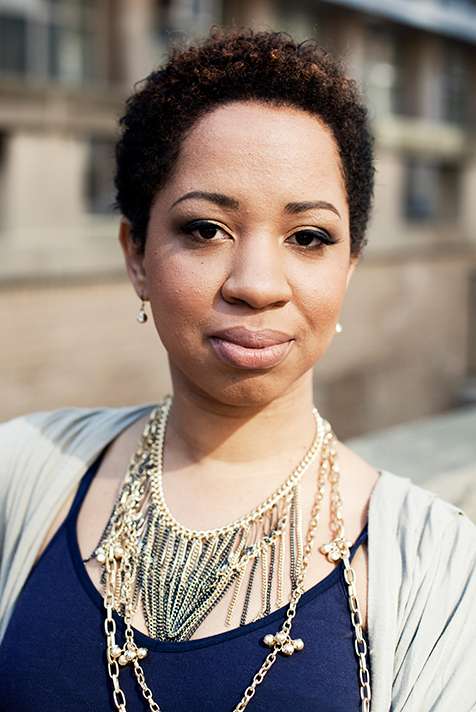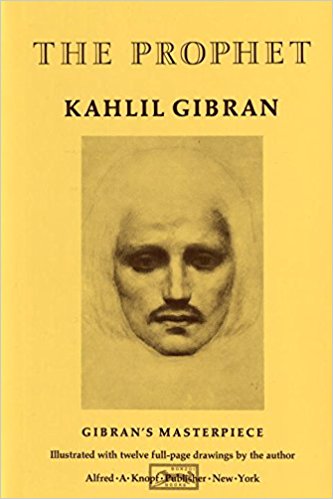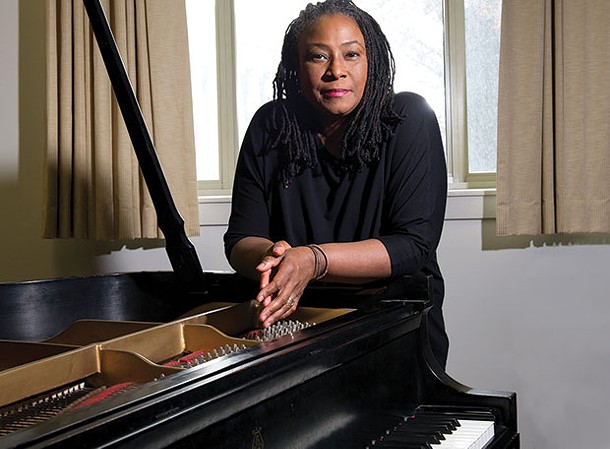Courtney Bryan, Composer & Pianist
 Courtney’s new work “In the Heart of God” will be performed tonight on Talea’s mainstage season finale. We sat down to chat about composition, Courtney’s diverse influences, and big-picture questions about diversity and inclusion that are coming to the forefront of conversations in jazz and classical music.
Courtney’s new work “In the Heart of God” will be performed tonight on Talea’s mainstage season finale. We sat down to chat about composition, Courtney’s diverse influences, and big-picture questions about diversity and inclusion that are coming to the forefront of conversations in jazz and classical music.
ZS: Let’s dive right in! Can you tell us more about who you are and where you’re from?
CB: My name is Courtney Bryan, and I’m a composer and a pianist. I’m originally from New Orleans, and I recently moved back home, summer of 2016, to start teaching at Tulane University, where I’m an assistant professor of jazz studies. I’m also a jazz artist, so that’s what I’m focused on in my teaching position. But, a lot of my projects are not so connected to jazz, too.
ZS: I didn’t realize that moving to New Orleans was actually a move back home, for you. And, it’s your first major teaching appointment, right? Has moving changed your thinking or your artistic practice?
CB: Yes, I’ve been thinking about this. The nice thing is that it’s a move back home, so it’s a familiar place. But, after a long time it is a little confusing. You remember the place and you think you know it. But, I’m really re-learning New Orleans. It’s pretty exciting, in terms of the music that’s happening. I’m just learning what the exciting things are, and who’s around. As far as the job, I’m also just learning what it means to balance a full-time professorship with being a full-time artist. Even though the position is teaching music, it’s a tricky balance.
ZS: How’s it going so far?
CB: Oh, you know, I feel crazy most of the time.
ZS: Don’t we all!
CB: Because I’m no longer in my early twenties, I’m not able to pull a bunch of all-nighters. I just have to prioritize and trust my creative process. Actually, this piece in particular was a good test with that.
Each project I take on is something I care about. Either it’s a group I want to work with or a topic I want to respond to. But, time is always an issue! Now, I don’t have as much time for brainstorming and trying out ideas, like I’m used to. It’s like: Start! …then meet the deadline. As far as writing In the Heart of God, I actually wrote it in just a few days, which was stressful.
ZS: I didn’t realize it was this quick!
CB: It’s a long story, but I actually had to start all over. So, instead of my usual process of collecting ideas and mapping things out, I just sat at the piano and improvised several takes based on the feeling of falling in love.

And, I had the quote from Khalil Gibran in my head. “When you love, you should not say ‘God is in my heart’, but rather: ‘I am in the heart of God’.” I had that in mind, and thought: I’m making a love song. I started to improvise this way, and I found something I liked. Then I looked at the full poem, and I realized it really does fit. In essence, I took my improvisation and used it as the basis to arrange for instruments.
ZS: I can’t wait to hear it! Do you often work this way, at the intersection of improvisation and composition? How much does this inform your practice?
CB: Improvisation is always a part of my process—and often collaboration, depending on the project. I usually work away from the piano, because it usually opens up my mind more to the possibilities with the instruments if I’m not starting from the piano. I just have certain things I naturally do on the piano—although of course I try to keep growing those, too.
I usually work visually, so I sometimes draw shapes that I’m thinking of. Sometimes numbers are an inspiration, too. I’ll collect all these ideas. I might start thinking of different melodies or harmonies, and that’s when I’ll bring in the piano into my process. But, then, I’ll go back to writing away from the piano.
This time was very different—and in many ways more like how I used to work a long time ago: starting at the piano. When I’m at the piano I might take the ideas and find ways to abstract them different ways, but this time it was like: “Oh, here’s what came out.” And basically I wanted to stick to what I was hearing in that moment. I wanted to trust that and orchestrate it.
ZS: Maybe it doesn’t relate so much to this piece, but at least in some of your other music you’ve been doing a lot with sampling recordings of jazz artists and incorporating them into your practice, and this makes me think of sampling in another tradition: hip-hop. I’m wondering if this informs your practice at all, or if you often think about this? Especially growing up in New Orleans?
CB: I’m glad you asked that, because I would definitely say that the process I use is influenced mostly by hip-hop: Thinking about sampling and building different ideas from recordings that already exist. And, yes, growing up I listened to everything. Being in New Orleans, there was a lot of music just around, usually with live instruments. There’s always some holiday and there are various second lines. Then, with the tourism economy, there’s also “performances” that re-create the original performances of the culture.
The record label Cash Money became big when I was in high school—and No Limit right before that—and in New Orleans we had our own style of music called Bounce Music. We didn’t listen to a lot of the national hip-hop, but when No Limit and Master P starting becoming national we started listening to more from the East Coast and the West Coast. Although, I suppose we always listened to the West Coast. I listened to a lot of Tupac growing up.
A piece of mine —“Songs of Laughing and Smiling and Crying”—reflects that in some ways. I’ve always been influenced by electronic music, but, I hadn’t yet ventured into creating electronic music. So, I was thinking about what the role of technology is in music, and the way I was hearing it.
 What wound up happening was me taking recordings of things and manipulating them. In 2012, Geri Allen was curating a month at the Stone and she invited me to do an hour-long show. I really wanted to do an hour-long solo piano piece using technology in some way. So, I looked at all these songs on the themes of smiling, laughing and crying. It included jazz artists, but it really included a lot of genres. It included opera—Placido Domingo singing Pagliacci—as well as Barbara Streisand, Dinah Washington, Screamin’ Jay Hawkins, Nicki Minaj, Tupac, Tony Bennett. I collected all these things. It ends with Charlie Chaplin’s “Smile”, including the voices of Stevie Wonder, Janelle Monáe, Michael Jackson, Nat King Cole. It’s also an opportunity to incorporate all the different types of styles that I play on piano. Since then, I’ve used a similar technique in other pieces.
What wound up happening was me taking recordings of things and manipulating them. In 2012, Geri Allen was curating a month at the Stone and she invited me to do an hour-long show. I really wanted to do an hour-long solo piano piece using technology in some way. So, I looked at all these songs on the themes of smiling, laughing and crying. It included jazz artists, but it really included a lot of genres. It included opera—Placido Domingo singing Pagliacci—as well as Barbara Streisand, Dinah Washington, Screamin’ Jay Hawkins, Nicki Minaj, Tupac, Tony Bennett. I collected all these things. It ends with Charlie Chaplin’s “Smile”, including the voices of Stevie Wonder, Janelle Monáe, Michael Jackson, Nat King Cole. It’s also an opportunity to incorporate all the different types of styles that I play on piano. Since then, I’ve used a similar technique in other pieces.
ZS: You know, I feel like arts organizations often talk about having eclectic or diverse programming, but someone like you just puts them to shame! You have such a sweeping knowledge of so many kinds of music, and incorporate them so thoughtfully into what you do. Has that always been a part of growing up in a melting pot of so many different musics—and having a love for so many different musics? Or is it something that you really try to actively incorporate into what you do?
CB: That’s a good question. I want to say it’s more about making a point to do it. But, now that you say it, I was always around it. Growing up, I went to a church called St. Luke’s Episcopal Church. Most of the members were from the Caribbean, along with a mix of people from South America, West Africa, and America. The music was often traditional hymns in the Anglican tradition. But, then, there was always a tambourine playing a calypso rhythm mixed with one of the hymns, or something! You have this sound from one tradition, but you add this other traditional rhythm to it.
But, at the same time, I was always in separate worlds. I was a classical pianist over here, and a jazz pianist over there. Later, I learned about how people try to separate composer from performer, even though I always thought they went together.

I think this is where social questions come in. People talk about styles, but I think race and gender play a role. I feel like being a black person in the classical world that I was the only person in my circle, so I would want to make sure I didn’t stand out. I wanted to be evaluated based on my music—I focused a lot on trying not to be “othered”, even though you can’t really control those things.
And, as a young woman in the jazz world, it’s the same thing. I was very conscious of certain things, like not playing too soft. Whatever stereotypes people had of what a girl would do in jazz, I wanted to do the opposite. I played really hard and really fast. I would get weird compliments, like “Oh, Courtney, you played like a man.”
ZS: As though that’s flattering, or something.
CB: Yeah. But, when you’re just trying to be taken seriously… you just want a chance to do your music. But, as I got older and got into more settings where it was allowed… well, no, no, I had to make it allowed… but I think as I got older I just wanted not to separate any part of myself. My goal was to be my full self in any setting, no matter what it is. This project in particular was me saying: I’m going to do all the things I do in one piece, but it’s all connected by everyday emotion.
ZS: I feel like this very genuine spirit is so clear in your music and something I like very much about it. I feel like it touches on this point George Lewis makes, for example: that new music is always defining things that it is not: that is jazz, this is hip hop, etc. But, it never defines what it is. It’s good at separating things into little boxes—except when it’s time to actually reflect critically on its own orthodoxy.
I was speaking recently about this with the bassist in Talea, Greg Chudzik, who is playing the solo part in Rebecca Saunders fury II. He also grew up playing both classical and jazz, and when he first moved to New York he was playing a lot of both. We were talking about a lot of these bigger conversations that are going on in new music, jazz, and classical music. I’m wondering if you can talk about the same question: these conversations on diversity and representation?
CB: I hate to answer that with “I don’t know.” But, generally, I have to say I’m not exactly sure. Right now, I don’t even know what world I’m in, although I guess I’m in the “new music” world, the parts of it that are open to jazz. One thing that’s in common with all the music worlds right now is the #meToo movement. First of all, I am happy that there has been a lot of focus on programming and diversifying in the classical world, because it is past time. It’s good to make moves forward.
The #meToo movement has been very interesting to me, since it’s stories that people have always talked about, but we’ve been so into celebrating the “great genius” at the expense of everybody around them. Some person does these horrible things, but they’re a great artist so we look the other way. I think it’s really empowering that people are speaking out.
As far as diversity discussions, I hear about conversations happening, but in the more traditional parts of the jazz and classical worlds, I wonder how much has changed regarding gender representation. However there are conversations happening on this issue, which is positive. There are conversations about how to include more women composers and composers of color. Or, just generally more diverse programming. It’s all very important, and recently I feel like I’m getting more formally involved in a lot of these discussions. And, I’m formulating my own opinion of the best way to go about things.
I guess the ideal is when people want programs to be more naturally diverse. American Composers Orchestra is a good example. When I go to their concerts, I feel like there are a lot of different voices represented—musically, as well as in terms of gender, race, ethnicity, and so on. I know Talea is talking about these issues, too.
ZS: Finally, then: going into the concert, is there anything in particular you’d want people to listen for or to know about your piece?
CB: Well, I think the process I described above is important to understanding it. But, I’ll also say this: I have had different inspirations in the past years, and I think some of my work that has gotten a lot of attention has been my work dealing with police brutality. I’m continuing on that path, but the natural progression as I’ve been thinking more about these themes is just thinking about life and death in general. This piece is about love, it’s about freedom. So, I guess what I am excited about with this piece is just to focus on the joy—with a little pain in it—and the idea of love. It’s really kind of simple, that way.
ZS: That’s wonderful. Thank you so much for sharing your time with me today, Courtney.
To see Courtney’s new work live, learn more, or purchase tickets for the concert on Friday, April 13th at St. Peter’s Chelsea, please visit: https://www.brownpapertickets.com/event/3371233
